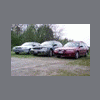Typically if you buy an autometer or any other such pressure gauge it is going to have 1/8" or possibly 1/4" NPT male thread.
You can search for mcmaster part # 4860K141 and 4860K151, or just jump to their catalog page 28.
Right on, you'd need this part to adapt the block 1/8" BSPT female to NPT:
First, the adapter set I have used in the past was sold by amsoil, stock #BP44, which were simply a set of adapters in a Stewart Warner box --> link Wherever you buy your gauge might have these adapters too; I have also gotten them in gauge adapter kits at pepboys.
4860K141 1 Each Brass Threaded Pipe Fitting, Bspt Male X Npt Female, 1/8" Adapter, 1" Length
Then if you want to keep the stock pressure switch as well, you need another adapter, i.e. 1/8"NPT male to 1/8" BSPT female:
4860K151 1 Each Brass Threaded Pipe Fitting, Npt Male X Bspp Female, 1/8" Adapter, 1" Length IMPORTANT NOTE: I am not sure this is the right part #. BSPP is british standard pipe, parallel thread - not sure if this will seal properly with a BSPT male
Also you might want to get some 1/8" NPT elbows, tees, nipples, etc or try to plan in advance how you're going to plumb it. There isn't a ton of room under the alternator to fit senders and such in down there, so I usually route the plumbing up behind the alternator and put my senders or whatever I'm doing there.
I'm going to give a lot of information here about the fittings, etc, because engine oil is mission critical to the engine. You really don't want any leaks.
For the 1/8" NPT elbows, tees, etc., I usually get the NPTF designation. These are also called 'dryseal'. It has a slightly modified crest and roots threading that makes it less likely to leak. You still need to use a thread sealant though.
NPTF thread fittings are compatible with NPT thread fittings.
For thread sealant, I just used teflon tape and didn't have any problems.
I have also used the Permatex high temp thread sealant and it works very well on brass fittings, especially if you use their 'activator' first (though the activator is like $10 for a little spray can). You MUST let the Permatex stuff harden at least 24 hours before applying pressure I have noticed or it will likely spring a leak.
Also with the Permatex, only the part down in the threads hardens. Any excess that you see left outside the fitting will not harden (just so if you use it and wonder why it doesn't seem to be hardening). You can just wipe off the excess.
Do not apply sealant to the first one or two male threads, otherwise the sealant may end up inside the plumbing and contaminate your process fluid (engine oil in this case).
For material, brass is fine. It may corrode slightly greenish I have noticed, maybe brass has copper in it I don't remember. You could go stainless, chrome, etc if you wanted but that's just more $$.
When you assemble the brass fittings, you might want to research first the proper tightening procedure. These fittings should NOT be tightened to a specific torque. You are supposed to thread the fitting finger tight, then there is a specific range of TPFT (turns past finger tight) you are supposed to use.
The correct number of TPFT varies on thread type and size. I think for 1/8" NPT&BSPT it is 2-3 turns but I would have to double check.
The correct number of TPFT gives the proper number of threads of engagement for a leak free seal. (You need sealant because these tapered thread fittings have a spiral leak path between the thread crests and roots.)
Mcmaster brass fittings will be fairly well machined for leak free fits. (I have noticed on black&galvanized pipe from home depot you often have to crank it another turn or two past the designated TPFT to prevent leaks; the threads just don't seem to be so good on some of them.)
And that's about it!
The rest of this thread is my rant about mcmaster.
<rant>Also I love http://www.mcmaster.com They have a huge selection of hardware and such, they do not abuse you on shipping, have no minimum order, I have never ordered an item they did not have in stock, they sell in small quantities, plus they have several warehouses so if you live near enough to one you get your stuff the very next day even by ups ground. All these factors make them a great supplier for the hobbyist, though probably most industrial companies order from them regularly.
McMaster typically doesn't tell you the manufacturer of the item on the web site. However I have been pleasantly surprised when I ordered something expecting a generic product and received a nice name brand such as Parker for fittings, Armstrong for impact sockets, etc.
Some of their main competitors would be mcjunkin, msc, and grainger, and to a degree fastenal.
Also McMasters web site is cleanly laid out, and they have a lot of technical information available, i.e. different metal alloys, material compatibility, fastener grades, thread types, etc, etc</rant>
Here's a pic of the plumbing nightmare in my '00obw:


